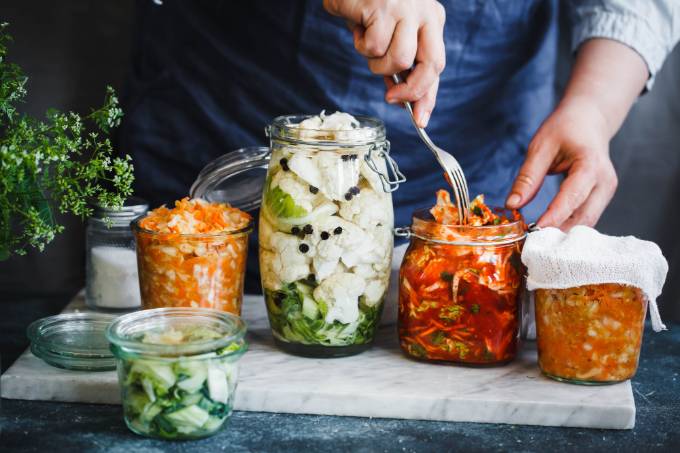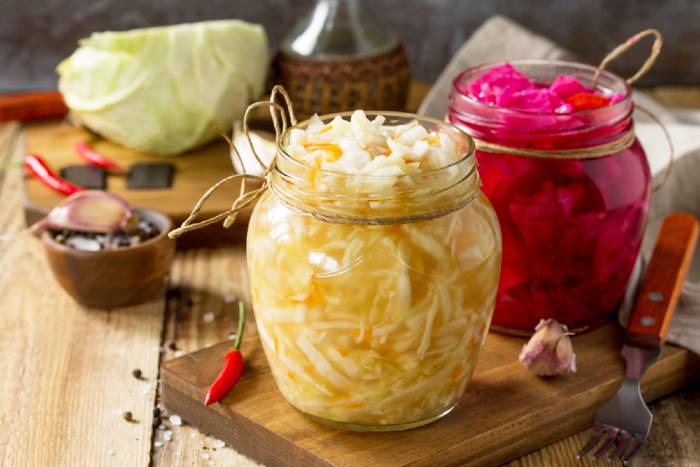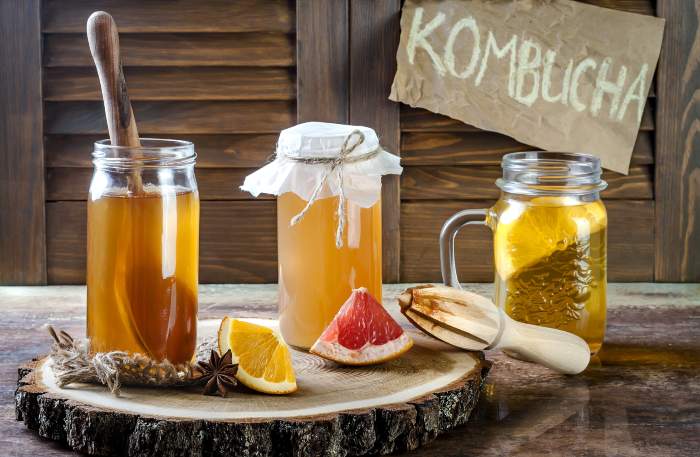Fermented Foods: One Step Better Than Raw

Make sure to like Living Green and Frugally on Facebook, Shop at Amazon to help support my site and explore our PINTEREST BOARDS for innovative ways you can become self-sufficient.
A burgeoning body of research is highlighting the pivotal role that gut health plays in our overall well-being. From boosting immunity to improving digestion and even influencing mood, maintaining a healthy gut is crucial.
One way to promote gut health is by incorporating fermented foods into your diet. Fermented foods are rich in probiotics, which are beneficial bacteria that aid in digestion and support a balanced gut microbiome. Here are seven must-eat fermented foods to include in your diet for a healthier gut.
1. Yogurt: Yogurt is perhaps one of the most well-known fermented foods, and for good reason. It is rich in probiotics, particularly strains like Lactobacillus and Bifidobacterium, which help maintain a healthy balance of gut bacteria. Opt for plain, unsweetened yogurt to avoid added sugars, and consider Greek yogurt for an extra protein boost.
Recipe:
- Ingredients:
- 4 cups of whole milk
- 2 tablespoons of plain yogurt (as a starter culture)
- Instructions:
- Heat the milk in a saucepan over medium heat until it reaches about 180°F (82°C), stirring occasionally to prevent scorching.
- Remove the milk from heat and let it cool to around 110°F (43°C).
- In a small bowl, mix the plain yogurt with a few tablespoons of the warm milk to thin it out.
- Stir the thinned yogurt into the remaining warm milk.
- Transfer the mixture to a clean glass jar or container, cover it loosely, and incubate it in a warm place (around 110°F/43°C) for 8-12 hours, or until it thickens and develops a tangy flavor.
- Once the yogurt is set, refrigerate it for several hours before serving.

2. Kimchi: Hailing from Korea, kimchi is a spicy fermented cabbage dish that is teeming with probiotics. It’s also packed with vitamins A, B, and C, as well as antioxidants. The fermentation process enhances its nutritional profile and flavor, making it a delicious and nutritious addition to your meals.
Recipe:
- Ingredients:
- 1 medium head of Napa cabbage
- 1/4 cup of sea salt
- 2 tablespoons of Korean red pepper flakes (gochugaru)
- 3 cloves of garlic, minced
- 1 tablespoon of minced ginger
- 2 green onions, chopped
- Instructions:
- Cut the cabbage into quarters and remove the core. Slice each quarter into bite-sized pieces.
- In a large bowl, toss the cabbage with the sea salt and let it sit for 1-2 hours, tossing occasionally.
- Rinse the cabbage under cold water to remove excess salt, then drain well.
- In a separate bowl, mix the red pepper flakes, garlic, ginger, and green onions.
- Add the cabbage to the spice mixture and toss until evenly coated.
- Pack the kimchi into a clean glass jar, pressing down firmly to remove air pockets.
- Cover the jar loosely and let it ferment at room temperature for 1-5 days, depending on your desired level of fermentation. Check the kimchi daily and press it down to keep it submerged in its juices.
- Once the kimchi reaches your desired level of fermentation, refrigerate it to slow down the fermentation process.

3. Sauerkraut: Similar to kimchi, sauerkraut is made by fermenting cabbage but typically without the spicy kick. It’s a good source of probiotics and contains compounds like glucosinolates, which have been linked to reduced inflammation and improved digestive health. Incorporate sauerkraut into sandwiches, salads, or as a side dish to reap its benefits.
Recipe:
- Ingredients:
- 1 head of cabbage, finely shredded
- 1 tablespoon of sea salt
- Instructions:
- In a large bowl, combine the shredded cabbage and sea salt.
- Massage the cabbage and salt together with your hands for 5-10 minutes, or until the cabbage becomes wilted and releases its juices.
- Pack the cabbage tightly into a clean glass jar, pressing down firmly to remove air pockets.
- Cover the jar loosely and let it ferment at room temperature for 1-4 weeks, depending on your desired level of fermentation. Check the sauerkraut daily and press it down to keep it submerged in its juices.
- Once the sauerkraut reaches your desired level of fermentation, refrigerate it to slow down the fermentation process.

4. Kombucha: Kombucha is a tangy, effervescent beverage made from fermented tea. It’s naturally carbonated and contains a variety of probiotic strains that support gut health. Additionally, kombucha contains antioxidants and polyphenols, which may have anti-inflammatory properties. Enjoy kombucha as a refreshing alternative to sugary sodas or as a midday pick-me-up.
Recipe:
- Ingredients:
- 4 cups of water
- 4 bags of black or green tea
- 1 cup of granulated sugar
- 1 SCOBY (symbiotic culture of bacteria and yeast)
- 1 cup of starter tea (previously brewed kombucha)
- Instructions:
- Bring the water to a boil in a large pot. Remove from heat and add the tea bags and sugar, stirring until the sugar is dissolved.
- Let the tea steep for 10-15 minutes, then remove the tea bags and let the tea cool to room temperature.
- Transfer the cooled tea to a clean glass jar and add the SCOBY and starter tea.
- Cover the jar with a clean cloth or coffee filter and secure it with a rubber band.
- Let the kombucha ferment at room temperature for 7-14 days, depending on your desired level of fermentation and the temperature of your environment.
- Once the kombucha reaches your desired level of fermentation, remove the SCOBY and starter tea and transfer the kombucha to clean glass bottles for storage. Optionally, you can flavor the kombucha with fruit juice or herbs before bottling.
- Seal the bottles tightly and let them carbonate at room temperature for 1-3 days, then refrigerate to slow down the fermentation process.

6. Kefir: Kefir is a fermented milk drink that originated in the Caucasus region. It’s made by fermenting milk with kefir grains, which are a combination of bacteria and yeast. Kefir is rich in probiotics, calcium, and protein, making it a nutritious option for supporting gut health. If you’re lactose intolerant, you can try non-dairy alternatives like coconut kefir or water kefir.
Recipe (Milk Kefir):
- Ingredients:
- 1 tablespoon of kefir grains
- 2 cups of milk (cow’s milk, goat’s milk, or non-dairy milk)
- Instructions:
- Place the kefir grains in a clean glass jar.
- Add the milk to the jar and stir gently to combine.
- Cover the jar loosely with a clean cloth or coffee filter and secure it with a rubber band.
- Let the kefir ferment at room temperature for 12-48 hours, depending on your desired level of fermentation. Check the kefir periodically until it reaches the desired taste and consistency.
- Once the kefir is ready, strain out the kefir grains and transfer the kefir to a clean glass jar for storage. Refrigerate the kefir until ready to use.
7. Tempeh: Tempeh is a fermented soybean product that originated in Indonesia. Unlike tofu, which is made from coagulated soy milk, tempeh is made from whole soybeans that are fermented with a starter culture. It’s a good source of protein, fiber, and probiotics. Tempeh can be grilled, stir-fried, or used as a meat substitute in various dishes.
Recipe:
- Ingredients:
- 2 cups of dried soybeans
- 2 tablespoons of vinegar
- 1 packet of tempeh starter culture
- Instructions:
- Rinse the soybeans and soak them in water overnight.
- Drain the soaked soybeans and cook them in fresh water for 30-40 minutes, or until they are soft.
- Drain the cooked soybeans and let them cool to room temperature.
- Mix the vinegar into the cooled soybeans and sprinkle the tempeh starter culture over the mixture.
- Transfer the mixture to a clean glass container and cover it with a clean cloth or coffee filter.
- Let the tempeh ferment at room temperature for 24-48 hours, depending on your desired level of fermentation. The tempeh should become firm and have a nutty aroma.
- Once the tempeh is ready, store it in the refrigerator and use it within a week.